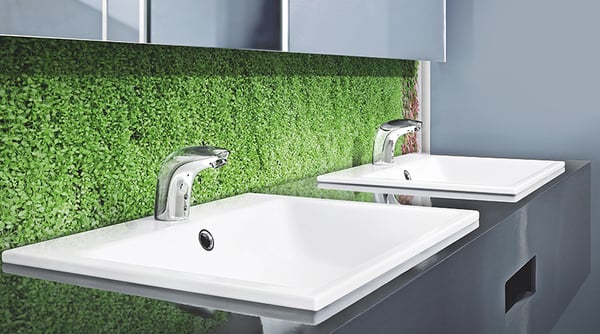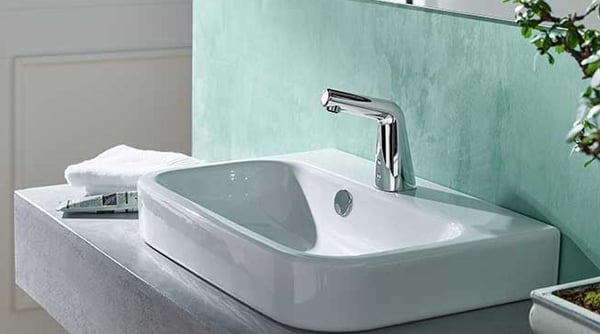As we consume more water in our bathrooms than anywhere else in the home, here are 6 simple sustainability tips— from taking shorter showers to switching to soap bars.

Many of us believe that adopting sustainable solutions means higher price tags. We get it: organic and eco-friendly alternatives are often more expensive than their regular, less sustainable counterparts.
Well, actually, there is much we can do to sustain our planet that requires minimum effort and little money, especially in the bathroom. Not only is it the room that sees the greatest consumption of water in any home, the use of electricity is particularly high, and tons of unnecessary plastic goes to waste every year.
We are not suggesting a complete overhaul. No costly renovations, nor fancy gadgets. Just a few adjustments to lifestyle choices and extra attention to what we pick on our next shopping trip can make all the difference.

Touchless faucets automatically turn of the water, when it is no longer needed.
Here are 6 easy tips for how to turn your bathroom greener:
- Less power in your shower – Just 5 minutes under the shower can consume up to 75 litres of water, roughly equivalent to the amount a family of 3 drinks every week. And while reducing the length of our showers will save water, by simply installing a low-flow showerhead, consumption can drop by 10 litres per minute without compromising shower time! We think that’s a pretty good deal.
- Turn off the faucet – Every time we brush our teeth, let’s make sure the washbasin faucet is turned off. There is no need for water to keep flowing while we brush — in fact, we can save up to 24 litres per day by simply turning off the faucet. That is equivalent to the amount each of us should be drinking over the course of a week.
And in case you are afraid of forgetting, touchless faucets can automatically do it for you. So why not switch?
- Reduce use of electricity – Keep in mind that hot showers not only consume water, but electricity too (assuming we all prefer washing under hot water). And your bathroom is most likely filled with energy-consuming devices — so whether your electricity source is renewable or not, why waste unnecessarily?
For example, unplug your devices when not in use (hairdryers, straighteners, electric razors and toothbrushes); install energy-saving lightbulbs and make sure you pick bulbs resistant to humid environments to avoid having to replace them often; don’t keep the exhaust fan on, just use it for the time it takes to ventilate: maybe 5 minutes and not half-an-hour.
- Give up liquid soap – Around the world, we dispose of 1.4 billion discardable soap bottles every year (and this excludes shampoos and conditioners). So why not opt for a good old soap bar, which is virtually free from any plastic packaging? Both are equally effective towards removing bacteria and dirt — and soap bars are, quite often, on the cheaper side too.
- Skip the drip – Did you know that a dripping faucet can waste enough water in one day to fill up a bath? That is roughly 80 litres. So apart from making sure lavatory faucets are properly turned off, we recommend investing in high-quality fixtures that are easy for plumbers to repair when needed.
- Switch to bamboo toothbrushes – Regular plastic toothbrushes produce an incredible amount of waste. To put things in perspective, over 1 billion are thrown away in the United States each year. An easy and widely available alternative is bamboo toothbrushes — they brush just as well and don’t generate plastic waste.
The planet’s wellbeing is at stake and we must all do our bit — and maybe our tips won’t save us from a climate catastrophe, but they can surely get us started.

-block-desktop-860x480.jpg?width=940&name=40210_Hansa_Vantis_Style_Basin01_Hansa_Vari_oh_IR.tif(1)-block-desktop-860x480.jpg)

-block-desktop-860x480%20(1).jpg?width=940&name=Oras_Romantic_V3.jpg(1)-block-desktop-860x480%20(1).jpg)



